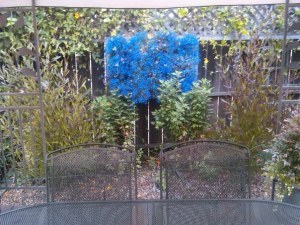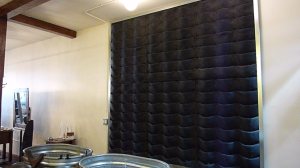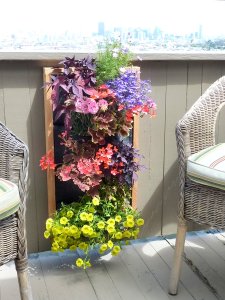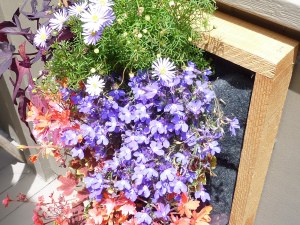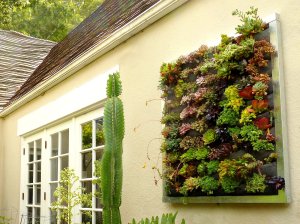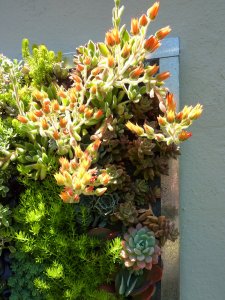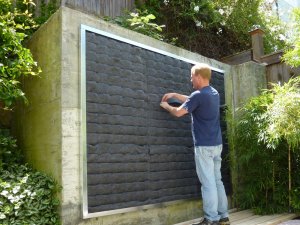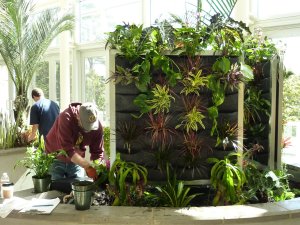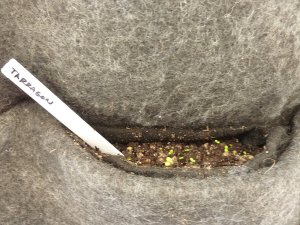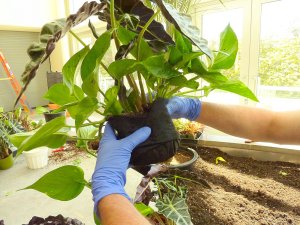Gilman Succlent/Sedum Living Wall Panel
Laura Gilman sent in this photo of their Mini-pocket panel with galvanized frame. After 4 months the succulents and sedums have gone wild. See original planting: http://plantsonwalls.blogspot.com/2010/07/gilman-succulent-garden-1-month-later.html
Population Hair Salon
Population Hair Salon on Divisadero Street in San Francisco (NOPA area) asked Plants On Walls to create a lush green jungle experience for their hair washing area. As the clients lean their heads back they will be enveloped in the tropics. Owner, Brian approves of the installation that was completed in one day prior to their soft opening. The entire system is on self-watering drip and drains to a floor drain on the back patio. Visit Population Hair Salon at 537 Divisadero St (between Fell St & Hayes St) San Francisco, CA 94117 (415) 440-7677 www.populationsalon.com
Floraframe in Los Angeles
The Garden Show at Modern Eden
A Floraframe was installed at Modern Eden Gallery for the upcoming show entitled The Garden Show. This vertical garden features a mini aquarium housing a small beta named Dew Drop. Come visit the installation and art opening on Saturday, July 17th from 6-9pm. Modern Eden, 403 Francisco St.,San Francisco, CA 94133, (415) 420-2898, www.moderneden.com
4-Pocket Herb Panel
Full 4-Pocket Panel with Cedar Frame
It's wonderful to have the flowers on my deck. I get direct sun on them so they are doing great. I water them about every 2 days and use a little MaxSea fertilizer in the water. It will drip on the deck if I water too much, but after a while you get used to just adding a little water and it will rarely drip. Because it is outside I don't worry too much. I used root wrappers to plant the pockets so I can easily change out the arrangement as I like and the cedar frame makes a nice finish. It's nice to have flowers without all the messy dirt and pots on my patio.
Floraframe: After 5 months
This Full-24 Pocket Floraframe has been thriving and evolving over the last 5 months. It's only light source is a 50-watt halogen flood bulb about 3 feet from the panel that is on a timer on daily for 8 hours. It's water is sourced and drained into a toilet's fresh water holding tank (in the room just behind the panel). A small fountain pump connected to a plug in timer waters the panel twice a week for 15 minutes. All of the plants are using root wrappers and the plants are fed with MaxSea fertilizer once a month, manually added by watering can. You can definitely notice when food is added how the plants burst out with new growth. It has been a delight to watch the panel grow and add and occasionally change plants around.
Ultimate Green Building Material
Plants On Walls vertical garden panels are a green building material that offers a multitude of positive environmental solutions.
- A Plants On Walls Full 12-Pocket Panel releases 1.6lb of carbon per panel in their manufacture. CO2 Calculation for the manufacture of a Full 12-Pocket Panel: Panel Weight (7 lbs) X Recycled PET Plastic (.23 lbs CO2 per lb of material) = 1.61 lbs of CO2 per panel. Recycling saves 90% of the CO2 released by making plastic. From: CO2 List
- Because the panels are extremely light weight and efficient a reverse carbon impact is possible from its lifecycle of hosting living plants. Living plants absorb carbon in the air through photosynthesis which offset the CO2 produced in manufacture. This in turn reduces global warming effects.
- Further carbon emissions are reduced by creating energy savings in buildings. In designing a Green Infrastructure west facing walls are covered with plants that create a cooling effect within the building. As plant material grows and regenerates itself the surface of a building is protected from sunlight deterioration. Together the living wall reduces cooling costs and extends the life of building materials, which saves money.
- Interior use has enormous health benefits because interior air is filtered and renewed with oxygen from the large number of living plants that thrive in a living wall. A NASA Study extensively has researched the use of house plants indoors.
- Water savings by maximizing efficiency: Growing food crops in vertical panels maximizes land use and hydroponics recycles water. Further efficiency can be obtained through Aquaponics that uses living fish to create food for plants offering a multitude of harvestable solutions.
- The felt used in Plants On Walls vertical garden panels is made from 100% recycled PET plastic water bottles. PET Plastic is highly durable, UV-tolerant, non-reactive and non-toxic. The panels can be reused indefinitely or completely recycled.
Floraframe Total System
The Floraframe total system includes the 24-Pocket Panel with galvanized frame and water tank, pump and timer. Shown here with a variety of tropical plants at Succulence Nursery in San Francisco.
Full Tropical Walls at SF Foliage
These two vertical gardens are on display at SF Foliage in San Francisco. Each living wall measures 5-1/2' wide by 8' tall. The walls were originally planted in May of this year. After two months the walls have grown in with very little attention. Today we re-arranged the plants slightly to make some design improvements and add some fresh color.
Large Succulent Wall Installation
Chris Bribach begins the installation of a large succulent wall installation by first installing vertical 'hat' channel to the concrete wall with screw anchors. He then attaches the drain tray and begins to add the Mini 30-Pocket Panels and side channels. Once all nine panels are screwed in to place the top channel is added and the felt pockets are made ready to receive soil and plants.
Laguna Honda Hospital Installation Continues
John Alexander and team from Community College San Francisco continue to assemble the vertical garden installation at Laguna Honda Hospital. The grand opening for the new construction is a week away; Saturday, June 26th.
Laguna Honda Hospital - Vertical Garden Planting
John Alexander directed the planting of the vertical garden and planters at Laguna Honda Hospital in its sun-filled main lobby. Fellow students from Community College San Francisco gardening department were there to help out.


